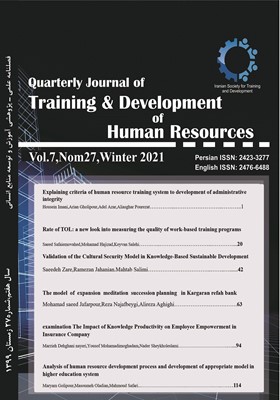Rate of TOL: a new look into measuring the quality of work-based training programs
Subject Areas :
Saeed Safaei Movahed
1
![]() ,
keyvan salehi
2
,
keyvan salehi
2
![]() ,
Mohammad Hajizad
3
,
Mohammad Hajizad
3
1 - Oil Co
2 - Tehran University
3 - Azad University
Keywords: Rate of TOL, training effectiveness, training quality, transfer of learning,
Abstract :
Training officials are often unable to prove how effective they are in meeting the business goals. We clearly admit that top managers need reliable and valid data to trust training functions, but training officials often lack justifiable indices to back up their claims about improving staff's performance in real work. Although ROI was a rigorous index to report on effectiveness of work-based training programs, but it did not turn into popular trend it is hard and costly to estimate. Hence, we here put forward a new index for reporting on effectiveness of work-based training programs, entitled Rate of TOL. This index aims at measuring how much of what participants learn during training programs transfers into performance in real workplaces. To do so, two strategies are suggested: firstly, Simple Linear Strategy (SLS) which is based on calculating coefficient of determination between scores of final course tests and performance appraisals; and secondly, Cluster Linear Strategy (CLS) which is based on calculating multiple regression between scores of final course tests plus other influencing predictor variables (such as work climate, personal motivation, etc.) and performance appraisals. It is finally argued that the proposed index just improves when training programs are designed and implemented in the best possible manner to meet quality measures like learners' satisfaction, relevance, importance, instructors' competency, and etc. Consequently, Rate of TOL as a quality index helps training and development officials to report more exactly and justifiably on how effective they are in improving people in real workplace.
فتحی واجارگاه، کورش و دیبا واجاری، طلعت(1395). ارزشیابی اثربخشی دورههای آموزشی، تهران: آییژ.
فیلیپس، جک و استون، رون(1393/2002)، اندازهگیری نتایج آموزش(راهنمای علمی برای پیگیری شش شاخص کلیدی). ترجمه کوروش فتحی واجارگاه، غلامرضا شمس مورکانی، و سعید صفائی موحّد. تهران: علم استادان.
کرک پاتریک، دونالد و کرک پاتریک، جیمز(1391/2005). ارزشیابی اثربخشی برنامههای آموزشی. ترجمه سعید صفائی موحّد و اعظم اسداللهی. تهران: آییژ
Aron, Arthur; Coups, Elliot J.; Aron, Elaine.N.(2013). Statistics for Psychology. Pearson Education, Inc. New Jersey.
Cramer, duncan(2003). Advanced Quantitative Data Analysis. Open university press, Berkshire Introduction to Stutistics in Psychology. Pearson Education Limited, Essex.
Holton, Elwood III(1996). The flawed four – level evaluation model. Huaman Resouurce Development Quarterly.(1) : 5-21.
Holton, Elwood F.III(2005). Holton’s Evaluation model: new edidence and construct evaluations. Advances in Developing Human Resources in Developing Human Resources.7(37) : 37-54
Holton, Elwood F.III; Ruona,Wendy E A (2000). Development of a generalized learning transfer inventory. 11(4) : 333-300
Leberman, Sarah; McDonald,Lex; Doyle,Stephanie(2006). The Transfer of Lerning. Gower Publishing Company, Burlington.
Perkins, David N.; Salomon, Garriel(1992). Transfer of Learning. In International Encyclopedia of Education. Pergamon Prress. Oxford.


